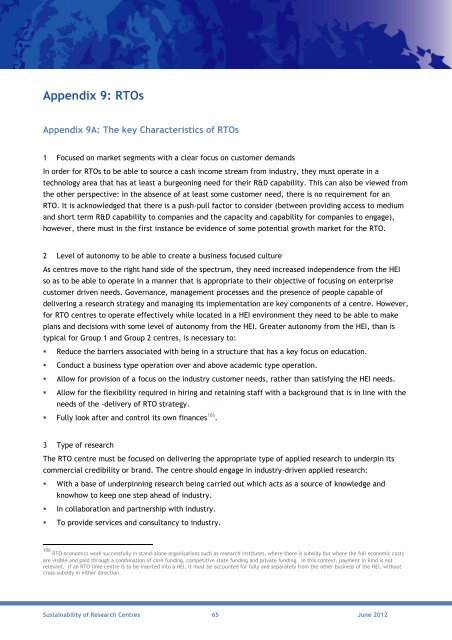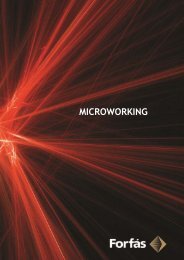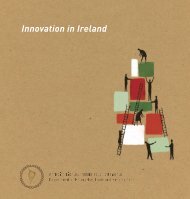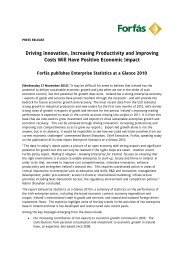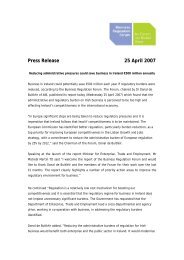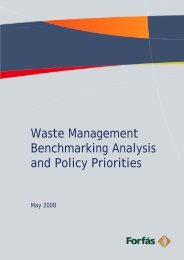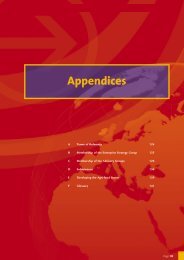Sustainability of Research Centres - Advisory Science Council
Sustainability of Research Centres - Advisory Science Council
Sustainability of Research Centres - Advisory Science Council
You also want an ePaper? Increase the reach of your titles
YUMPU automatically turns print PDFs into web optimized ePapers that Google loves.
Appendix 9: RTOs<br />
Appendix 9A: The key Characteristics <strong>of</strong> RTOs<br />
1 Focused on market segments with a clear focus on customer demands<br />
In order for RTOs to be able to source a cash income stream from industry, they must operate in a<br />
technology area that has at least a burgeoning need for their R&D capability. This can also be viewed from<br />
the other perspective: in the absence <strong>of</strong> at least some customer need, there is no requirement for an<br />
RTO. It is acknowledged that there is a push-pull factor to consider (between providing access to medium<br />
and short term R&D capability to companies and the capacity and capability for companies to engage),<br />
however, there must in the first instance be evidence <strong>of</strong> some potential growth market for the RTO.<br />
2 Level <strong>of</strong> autonomy to be able to create a business focused culture<br />
As centres move to the right hand side <strong>of</strong> the spectrum, they need increased independence from the HEI<br />
so as to be able to operate in a manner that is appropriate to their objective <strong>of</strong> focusing on enterprise<br />
customer driven needs. Governance, management processes and the presence <strong>of</strong> people capable <strong>of</strong><br />
delivering a research strategy and managing its implementation are key components <strong>of</strong> a centre. However,<br />
for RTO centres to operate effectively while located in a HEI environment they need to be able to make<br />
plans and decisions with some level <strong>of</strong> autonomy from the HEI. Greater autonomy from the HEI, than is<br />
typical for Group 1 and Group 2 centres, is necessary to:<br />
Reduce the barriers associated with being in a structure that has a key focus on education.<br />
Conduct a business type operation over and above academic type operation.<br />
Allow for provision <strong>of</strong> a focus on the industry customer needs, rather than satisfying the HEI needs.<br />
Allow for the flexibility required in hiring and retaining staff with a background that is in line with the<br />
needs <strong>of</strong> the -delivery <strong>of</strong> RTO strategy.<br />
Fully look after and control its own finances 106 .<br />
3 Type <strong>of</strong> research<br />
The RTO centre must be focused on delivering the appropriate type <strong>of</strong> applied research to underpin its<br />
commercial credibility or brand. The centre should engage in industry-driven applied research:<br />
With a base <strong>of</strong> underpinning research being carried out which acts as a source <strong>of</strong> knowledge and<br />
knowhow to keep one step ahead <strong>of</strong> industry.<br />
In collaboration and partnership with industry.<br />
To provide services and consultancy to industry.<br />
106 RTO economics work successfully in stand-alone organisations such as research institutes, where there is subsidy but where the full economic costs<br />
are visible and paid through a combination <strong>of</strong> core funding, competitive state funding and private funding. In this context, payment in kind is not<br />
relevant. If an RTO-lime centre is to be inserted into a HEI, it must be accounted for fully and separately from the other business <strong>of</strong> the HEI, without<br />
cross-subsidy in either direction.<br />
<strong>Sustainability</strong> <strong>of</strong> <strong>Research</strong> <strong>Centres</strong> 65 June 2012


